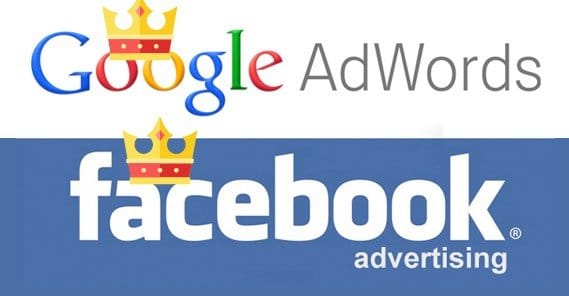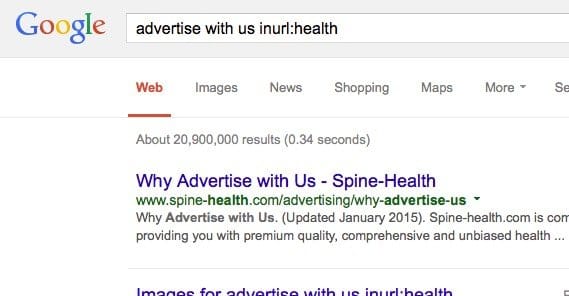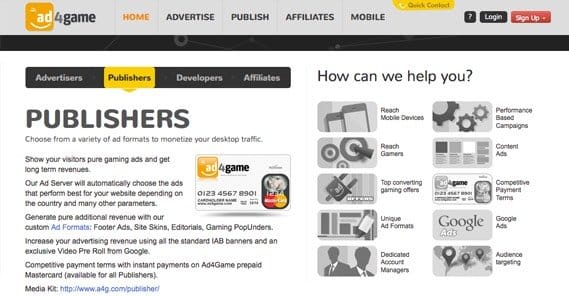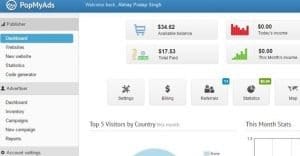Complete List of over 100 PPC Ad Networks

No, this isn’t just a huge list. There will be a huge list, and if all you’re looking for is a list, feel free to skip to the final sections. You’ll know it when you see it. If not, stick around, and we’ll discuss ad networks in general, how to identify a good network or a bad one, and why you might want to use any of them.
Why to Use Ad Networks Besides Facebook and Google
The first question you need to ask yourself is why would you ever use a third party ad network? When I say third party, in this context, I mean ad networks that aren’t Google and Facebook. Google and Facebook together run the two biggest ad networks in the world, and they’re as big as they are for very good reasons: they’re excellent. If you want to lump in the third largest, Bing’s ad network, you can even do that as well.
These ad networks have significant advantages over third party networks. They have massive exposure, for one. Facebook’s ads are limited to Facebook itself, but Facebook has over a billion users. You have insane potential for visibility. Google, meanwhile, also reaches over a billion users, with over a trillion views every month. That’s not a typo, that’s trillion with a T.
Both sites have so much ability to track and contextualize traffic that their ads can be extremely well targeted. Facebook actually comes out ahead here, just because so much of the information people post on Facebook is tracked and recorded.
Both sites, because of their size, can offer ads for an incredibly low price. However, that leads into one of the primary downsides to these networks; size, targeting and competition.
Sure, you can fight your way down to clicks for a single penny on both services, but those clicks are going to be untargeted and mostly valueless. When you add targeting to reach valuable members, your price increases. In most niches, there’s enough competition for attention that you have to pay even more to reach your target audience with any regularity.
So, a large audience and potentially low costs are counterbalanced by potentially high costs and stiff competition. There are, though, other reasons you might not be using Facebook or Google. For one thing, certain geographic locations are restricted, particularly from Facebook. They are a very US-centric platform, despite their global reach.
Then there’s always the instance where you’ve been blocked or banned from using one or both services. I’m not going to judge why you might have encountered this. I’ll just say that it happens, and that some otherwise innocent marketers are forced to use third party ad networks just to subsist.
Alternatives to Ad Networks
Before we get into more about ad networks in general, let’s discuss a little about what you can use instead of an ad network. There aren’t many options, which is unfortunate. The convenience of ad networks has made other solutions more difficult to manage.
One thing you can do is search the Internet for phrases like “advertise with us”. When you do, you’ll find a lot of sites that run ads on their own site, but aren’t part of a network. You’ll need to do some hunting to find sites in your niche and industry, but what else is new?
Buying ad space directly on sites used to be the norm, until ad networks made it infinitely easier on the sites. Instead of managing rotations and tracking expenses manually, the site owner only had to install some code and let the network do the rest. There’s no wonder why they changed in the way they did.
Another option is to find an ads marketplace. I like to reference BuySellAds for this, though they’re sort of a hybrid. They’re an ad network in the sense that you go through one platform to put your ads in many locations, but they’re more of a marketplace because you have more control over your ad locations and displays.
What to Look For in an Ad Network
There’s a lot that goes into making an ad network worthwhile to use. I’m going to give you a huge list of ad networks, but I in no way guarantee or verify their quality. Frankly, I don’t have the time or the budget to spend on running ads on hundreds of networks just to test them out. I’ll leave that to someone who specializes in reviewing ad networks with honest, unbiased reviews.
Speaking of reviews, ad networks are marketers. The worst ad networks are shady marketers who want to convince you to use them, so they can skim money off the top and generally provide poor traffic and poor ad placement. Unfortunately, the worst marketers are often the savviest when it comes to immoral tricks. They have absolutely no qualms about spamming fake reviews and paying for positive press, just to get that reputation to a point where people trust them when they shouldn’t. So, while you should always investigate any ad network you want to use before you use it, you should always take reviews with a grain of salt.
The general topics of the ad network is an important indicator to monitor. Topic is often divided by industry, so you might see an ad network with 75% fill rate in Gaming sites and 25% fill rate in tech and hardware sites. You wouldn’t necessarily want to promote a hardware site through this network, though it would be feasible to do. You certainly wouldn’t want to promote your knitting business; the interests don’t align and people will ignore your ads as irrelevant.
You also want to look for an ad network that offers retargeting tracking, either as something you can do or something they have built-in to their system. Retargeting, also known as remarketing, is the ability to track users who are interested enough to click through your ads to your site, but not interested enough to convert. Often times, these people are perfectly willing to convert, eventually, but the time isn’t right.
They might have questions about your product, or they might be at work and want to save it until they’re home, or they might be browsing via mobile and want to save your site for later. In any case, it’s very common for these users to be interested, but they also forget about you when they leave the context they were in when they found your ads. By the time they get home, they have forgotten what they wanted to buy.
Remarketing flags these users and allows you to target specifically those users with another wave of ads. Facebook is a great ad network to use for this, with their tracking and conversion pixel, but many ad networks offer at least rudimentary tracking in the form of cookies or a login.
You should also pay attention to what types of ads the ad network runs. Do they specialize in banner ads? Do they run background sidebar ads? Do they have pop-ups or pop-unders, with or without modal windows? Do they use contextual ads, text ads, native ads? Ad placement has a dramatic effect on user experience. Most ad networks will offer a variety of different placements, but some will specialize. Outbrain, for example, specializes in native ads, while AdSense primarily does textual ads at this point.
Another factor to watch is mobile compatibility. Can your ads show up for mobile users? Some networks will specialize in mobile, while others will do both, and still others only do desktop ads. Mobile can be very useful for certain types of marketing, including primarily app marketing and hyper-local geotargeted marketing.
Geotargeting, and targeting in general, is another thing to watch out for. Some ad networks will have the absolute minimum amount of interest-based targeting, and some won’t even let you specify anything more than a broad interest category. Others, meanwhile, will get into demographic information like what you can find with Facebook and Google.
You always want to make your ads as targeted and as relevant as possible. The less control you have over your targeting, the more likely your ads are to show up on irrelevant sites, which means the users seeing them aren’t going to be interested.
The Publisher’s Take
A lot of what I just wrote has to do with the advertiser’s side of the coin. It’s what you need to consider, and what you’re concerned about, when you’re going to pay an ad network to run ads for your business. There’s another side to the coin, though, and that’s the publisher’s side.
In order for an ad network to be successful, that network needs a lot of sites willing to display their ads. This means the network needs to treat publishers right, and there are a lot of things you need to look out for as a publisher to make sure this is the case.
- Ad placement is a big one. Do they require your ads to be placed in specific locations, and if so, does it conflict with your site design?
- Ad sizes are also important, for all of the same reasons.
- Can you run ads other than the network in question. Some ad networks require an exclusivity contract and can cancel your account – seizing your unpaid balance in the process – if you run ads from another network. Depending on the network, this may or may not count ads for your own products and services.
- What do they charge advertisers, and how much of a cut do they take? Some networks do 50-50, some do 70-30, some take even smaller commissions. Know how much you can get paid, and how much the network is getting paid for being the middleman.
- What are the payment terms? Do they pay monthly, weekly, or whenever you reach a certain threshold? How long does it take them to process and deliver a payment? If they take a long time to process and require a high minimum balance, they might be preying upon low volume advertisers who never meet that threshold, effectively giving them free money.
- What is their fill rate? If you’re dedicating space to ads, you want that space to be filled with ads. If they have a fill rate under 100% in your industry, be cautious.
- Do they have a contract, and if so, how long is the contract? If you’re signing on with a network for three years, you want to make sure they’re a damn good network.
Are Niche Specialty Ad Networks Worthwhile?
One thing you’ll notice when you browse the list – yes, I’m getting to it – is that a lot of the networks are going to be relatively small, niche networks. That’s not to say they have low payouts or low traffic, depending on your side of the coin. I just mean that they aren’t as broad and general interest as Facebook, Google, or the other big names.
Why might you want to go for a smaller niche network over a larger network? There aren’t a lot of reasons, unfortunately. In addition to the reasons not to use Facebook or Google themselves, you only have a few driving factors.
Probably the biggest factor is, well, niche. An ad network dedicated to one topic will tend to know that topic inside and out, and will be more guaranteed to give you high quality traffic interested in that niche. The downside to this, of course, is that niche networks tend to be smaller and have more tertiary sites in their networks rather than the big names.
The other factor I like to bring up is personal connections. A small network needs to fight to survive, and one way they can do that is by providing personal, quality support. A dedicated account manager, fast payments, easy Q&A; it’s all part and parcel of a good niche network.
Why Run Multiple Networks
One reason that I’m listing so many networks is so that you can try to use more than one with your marketing. As long as they don’t make you sign an exclusivity contract, this can be a means to diverse and varied traffic. These networks wouldn’t exist if Google and Facebook were everywhere; they aren’t. The real purpose for many of these networks is to be supplemental to your other marketing efforts.
A Huge List of Ad Networks
Finally! Before I get to the actual list (yes, I can hear your groans from here) I’m going to preface this by saying I make no guarantees as to the quality of the networks listed below. I’m not doing a lot of research into them, partially because everyone has different experiences, and partially because the traffic you get from one might be good for your site and not for someone else’s. All I’m guaranteeing is that as of now, June 2015, these sites all exist. That’s one of the biggest problems with ad networks, particularly the small ones; old lists go stale, sites die, sites rebrand, and sites are bought.
Now: the networks.
- 152 Media
- 7Search
- Ad Juggler
- Ad Knowledge
- Ad On Network
- Ad2One
- ad4game
- Adblade
- AdBull
- AdClick Media
- Addoox
- AdEngage
- Aditall
- Adjug
- Adly
- AdManage
- AdMedia
- AdOptim
- AdPepper
- Adperio
- Adperium
- AdReady
- AdTegrity
- Adult ad World (Adult)
- AdultSense (Adult)
- Adverline
- Advertising Alliance (Europe)
- Advertising.com
- Advertstream
- Advideum
- Affiliate Window
- Affinity
- Affiz
- Aim4Media
- AirPush
- Amazon Associates
- Amobee
- Ampush
- Applifier
- Applixir
- Appnext
- Bannerconnect
- Be On
- Bidvertiser
- BlogAds
- Brightroll
- BueSnap
- BuySellAds
- BuzzCity
- CBS Interactive
- Chitika
- Choker Traffic
- CJ Affiliate by Conversant
- Clickbank
- Clickky.biz
- Clicksor
- Clove Network
- Collective – The Audience Engine
- ConcoursMania (French)
- Conversant Media
- Coreg Media
- CPMStar
- CPXi
- CrakMedia (Europe)
- Criteo
- Digg Sponsored Posts
- Direct CPV
- DSNRMG
- Ebay Enterprise
- Elephant Traffic
- Emergent (Formerly Live Gamer)
- EngageBDR
- Epom Market
- Ero-Advertising
- Etology
- Exoclick
- Exponential
- Facebook’s Ads
- Find It Quick
- GloGaming
- Google’s AdSense
- HarrenMedia
- HiMediaGroup
- iAd (Apple’s Ads)
- Imgur Promoted Images
- Improve Digital
- Index Exchange
- Industry Brains
- Infolinks
- Innity
- Intergi
- Intermarkets
- Izea
- Juicy Ads (Adult)
- Jun Group
- Komli
- LeadImpact
- LifeStreet
- LinkConnector
- LinkedIn Ads
- LinkWorth
- Live Intent
- LiveRail
- LookSmart
- Matomy
- Maudau
- Media Traffic
- Media.net
- MediaBrix
- MediaStay
- Microsoft’s AdCenter (Bing Ads)
- Millenial Media
- Mirago
- Miva
- ModeMedia
- Mojiva
- MyAds
- MyThings
- Next Perf
- Nextperience Network
- One by AOL
- Open X
- Opera Mediaworks (Hunt Mobile Advertising)
- Outbrain
- Peanut Labs
- PlayWire
- PocketCents
- POF
- Premium Access
- Promote Clix
- Publicidad (Europe)
- Pubmatic
- Pulse360
- Rakuten Marketing
- RealTechNetwork
- Reddit Advertising
- Redux Media
- Reseau Select (Europe)
- Retargeter
- RevContent
- RevTwt
- Rhythm One
- RockYou
- Rubicon Project
- Ryan Isabella
- Salem Web Network
- Selectable Media
- Share Through
- ShareASale
- She Network (Europe)
- SiteScout
- Skimlinks
- Smowtion
- Social Game Media
- Social Reality
- Social Vibe
- Specific Media
- SponsoredTweets by Izea
- Spot X Change
- Sticky Ads
- StumbleUpon Ads
- Supersonic
- Switch Concepts
- Teads.tv
- Technorati Ads
- TradableBits
- Traffective
- Traffic Broker
- Traffic Junky
- Traffic Vance
- TrafficForce
- TrafficHolder
- Traffiq
- Tremor Video
- TrialPay
- Tribal Fusion
- TubeMogul
- Underdog Media
- Undertone
- Unified Social
- Unity Ads
- Unruly.co
- Vibrant Media
- Videology
- WeeWorld SGA
- Wildline (Adult)
- WildTangent
- Woobi
- Xaxis
- Yahoo Advertising
- Ybrant Digital
- YouTube’s Partner Program
- YouYield
- YuMe
- Zedo
 ContentPowered.com
ContentPowered.com






